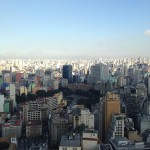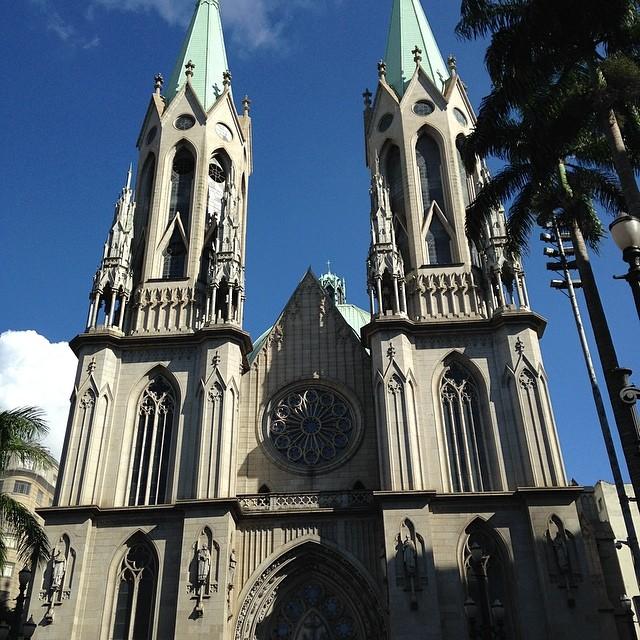 For faithful followers of the Melibee blog, you may recall my post from last year recounting my first visit to South America and the wonderful surprises I encountered as a result of my previous international travel being in Western Europe. I was excited, then, when I found out my work wanted to send me back to Brazil, this time offering me a slightly longer period of time in a single location. Though I appreciated that I was able to see a good smattering of locations on my whirlwind tour the previous year, the prospect of getting to spend one week in a single city to gain a more comprehensive perspective about what life in that city really might be like was enticing, even if the city I was going to just so happened to be the largest city in the southern hemisphere: São Paulo.
For faithful followers of the Melibee blog, you may recall my post from last year recounting my first visit to South America and the wonderful surprises I encountered as a result of my previous international travel being in Western Europe. I was excited, then, when I found out my work wanted to send me back to Brazil, this time offering me a slightly longer period of time in a single location. Though I appreciated that I was able to see a good smattering of locations on my whirlwind tour the previous year, the prospect of getting to spend one week in a single city to gain a more comprehensive perspective about what life in that city really might be like was enticing, even if the city I was going to just so happened to be the largest city in the southern hemisphere: São Paulo.
In my office, I am in charge of preparing our pre-departure materials for students going abroad. You would think that I was well equipped to prepare for my experience. However, in the weeks leading up to my departure, I found myself feeling unsure of where to start. How does one prepare for a short visit in one of the world’s busiest metropolises, especially when most of my cultural knowledge is steeped in Western European traditions? I found myself spending hours reading expat blogs about living in São Paulo and, thanks to the World Cup, scouring numerous news pieces about the city. Unfortunately, most of what I was reading suggested that I was going to one of the most dangerous places in the western hemisphere, not to mention my friends and family made incredulous remarks about my decision to go through with a visit to such a ‘precarious’ location, especially during such a volatile time.
Thankfully, as usual, what I discovered after my short visit to Sampa was that the U.S. media has aided with the persistence of a single story about the city, country, and Brazilian people. To be sure, my cursory takeaways from Brazil find it to be a country of contradictions and of course, I’m sure there are unsafe areas, but I in no way felt in danger at any point of my trip and actually found many things to be quite different from what I was expecting. Here are just a few takeaways from my trip that will hopefully help to change the single story of São Paulo and Brazil.
São Paulo: The organized beast!
Not having even an iota of experience with the Portuguese language, I was very nervous about navigating such a large city. However, from the moment I arrived in Guarulhos International Airport, I was relieved to see just how organized many aspects of the city actually were. The new international terminal built for the World Cup was signed extensively and made my transfer from the plane, through customs, to baggage claim, to the taxi stand among the easiest I can recall in my international travels. Though it was hard to wrap my head around the organization, if there can be said to be such a thing, of the overall city of São Paulo, actually getting around proved relatively simple. The metro is a really nice and efficient way to get to many of the city’s main sites (as long as it is not during rush hour) and it’s pretty intuitive. The bus lines can be as confusing as is the case in other major cities; however, a little research online beforehand remedies this. All in all, I felt a sense of triumph that I made it to all my appointments with time to spare and without having to lament my lack of Portuguese skills.

Paulistanos–Friendly New Yorkers!
São Paulo is frequently compared to New York City, however I was very heartened to see that the comparisons may only apply to its massive size and many cultural offerings. In terms of the people, I found the Paulistanos with whom I interacted to be very warm and friendly. From my AirBnB host, who greeted me with warm, freshly-baked bread upon my arrival, to the poor waiters who had to put up with my hopeless pointing at the menus, I never had a cold or brisk encounter. On the one day I had to play tourist, I was even approached by a Paulistano as he saw me with my head buried in my travel book attempting to find the iconic Catedral da Se.
On the sidewalk of a busy avenue, he approached me, tapped me on my shoulder, and in English asked if I needed any help. Talk about shock, are we still in 2014? I told him what I was looking for and he pointed me in the right direction and gave me a friendly wave as he went back along his way. It might not seem like much, but after some of the less-than-successful attempts at asking locals in Paris how to find different points of interest, to have a native in one of the world’s largest cities approach me and offer help was a pleasant surprise!

It’s Brazil’s Time to Shine!
On this, my second trip to Brazil, the fact that it is ready to show the world who it is as a country and what it has to offer was again made clear by everyone with whom I interacted. I suppose as an outsider having talked about the BRIC countries in many of my college courses, I wasn’t necessarily thinking that the Brazilians I encountered would know that their country was under a microscope to much of the rest of the world–but they definitely are cognizant of this fact. I was in São Paulo right before the start of the World Cup, and many of the young people with whom I spoke expressed concerns about whether or not Brazil was ready for an event of this scale. Let alone all of the disagreements with their government and spending on the event, the people I met knew that a lot was at stake and that all eyes would be on Brazil, and they wanted to show the world how diverse and exceptional their country really is. As I spoke with colleagues and new friends, I learned of a sort of contradiction–the Brazilians seem highly critical of their country, its government, and the people, yet there is a true sense of pride in Brazil in spite of its shortcomings. It reminded me of the first time I studied abroad. I had done my fair share of USA bashing given that it was right around the start of the Iraq war, however, after I traveled abroad, I found myself learning to love my home country in spite of its own flaws. It’s no different for Brazil–there is much still that the country needs to sort out for itself, but with the pride and charisma of its people, it will rise above the stereotypes, and I am excited to continue learning about all that it has to offer and watching it become a must-see destination that rivals many Western European locales!
Editor’s note: This post only gets better if you listen to some Brazilian music on while reading it!)

